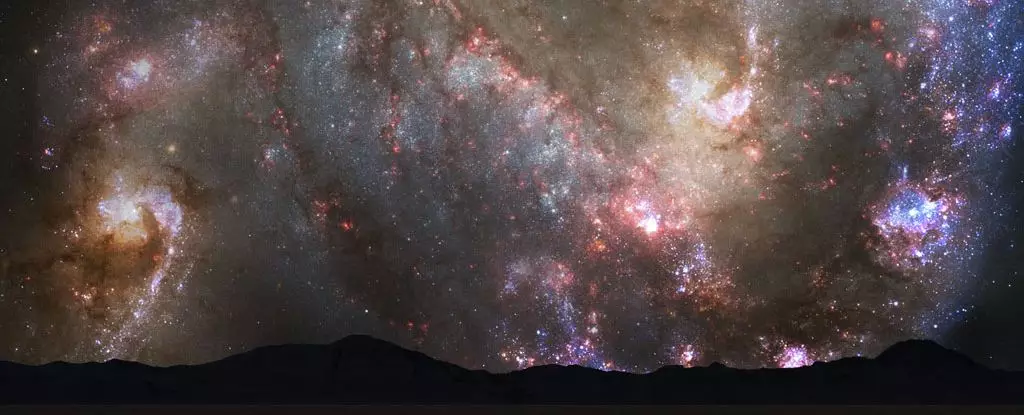For years, scientists have been vocal about the eventual collision between the Milky Way and the Andromeda galaxy, a cosmic event that has been labelled “Milkomeda.” However, a new study suggests that these predictions might be more dramatic than warranted. Astrophysicist Till Sawala and his team at the University of Helsinki have delved into this astronomical enigma and have opened the door to a far less catastrophic view of our galaxy’s future. The results indicate that the probability of a merger is close to 50%, suggesting an equal chance of a collision or an elegant passage in the grand expanse of space. Rather than viewing this as a certainty, one must now consider it one of several potential outcomes.
Parsing Through Previous Assumptions
The previous consensus leaned heavily towards a collision, marking it as an almost inevitable reality within 4.5 billion years. However, as Sawala’s research elucidates, the situation is laden with complexity. The new study reflects previous results when utilizing the same foundational assumptions yet diverges by offering a broader perspective. By incorporating the latest data from state-of-the-art space observatories—namely, the Hubble and Gaia telescopes—the team has suggested that variables previously underestimated could sway the trajectory of our galactic neighbors.
This willingness to question long-held beliefs is commendable and necessary in scientific inquiry. While it’s easy to accept the notion of catastrophic galactic collisions, a more nuanced understanding of gravitational interactions provides insight into the unpredictable nature of cosmos events. The findings remind us that science often progresses through revisions and re-evaluations of existing knowledge.
Impact of Other Celestial Bodies
One of the most fascinating elements of this research is the role smaller galaxies, such as the Triangulum (M33) and the Large Magellanic Cloud (LMC), play in shaping the future of Andromeda and the Milky Way. Sawala’s simulations demonstrate that these nearby galaxies significantly influence the potential collision course of the two larger spirals. In scenarios with only the Milky Way and Andromeda, collisions were anticipated slightly more than half the time, whereas the inclusion of M33 raised this probability to nearly two-thirds. Conversely, factoring in the LMC destabilized this likelihood, reducing it to about a third. This interactive web of gravitational influences shows that our Universe is anything but orderly; it’s a chaotic interplay of forces that could lead to unforeseen outcomes.
Understanding the gravitational dynamics between celestial bodies is crucial for predicting future encounters, and this study amplifies the importance of a broader perspective. The presence of these smaller galaxies alters the stage on which the Milky Way and Andromeda play out their dance, reminding us how interconnected cosmic systems truly are.
The Challenge of Cosmic Forecasting
While the study provides a wealth of insights, it also acknowledges the inherent uncertainty in predicting the cosmos. As we try to map out the next 10 billion years, the challenge lies in the unpredictability of countless variables that could emerge. Sawala points out that while current technology provides excellent data, the long term still holds mysteries that could pivot our trajectory dramatically. Each new discovery has the potential to enhance our understanding, yet also adds layers of complexity to our predictions.
This sentiment resonates deeply with the nature of scientific exploration itself: it’s a journey fraught with uncertainties, revelations, and the occasional curveball—much like the unpredictable nature of space-time. Recognizing this complexity allows us to engage with the cosmos not just as observers but as participants in an ongoing narrative that is infinitely richer for its uncertainties.
Looking Beyond the Horizon
Sawala’s research does not aim to provide a definitive answer to the fate of our galaxy but to highlight the vibrant canvas that is our Universe. The interactions and dynamics at play invite further inquiry, and this study serves as a call to action for future astrophysical explorations. The landscape of our cosmic neighborhood is shifting; ongoing observations from advanced instruments will further refine our understanding of mass and motion among the Local Group, potentially leading to more accurate simulations.
It’s essential that we cultivate a mindset receptive to new information and adaptable to evolving theories. Science is a path of growth—one that encourages curiosity and critical examination of even the most established beliefs. While the potential collision between the Milky Way and Andromeda has raised eyebrows for years, the new research reaffirms that in cosmic terms, there are myriad scenarios. Perhaps, rather than await the doom of “Milkomeda,” we would do well to appreciate the beautiful uncertainty that comes with gazing into the stars.

